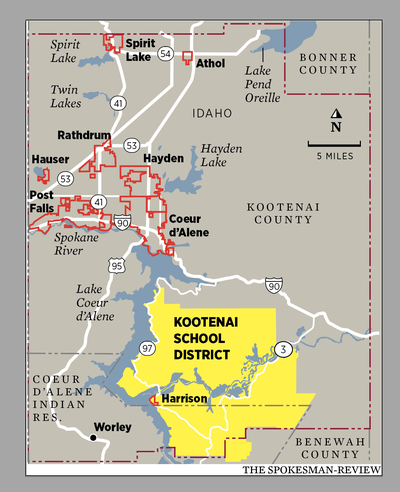Kootenai Joint School District asks voters for levy for sports, teachers, roofs and other items

Voters living within the boundaries of Kootenai Joint School District, located near Harrison, are being asked to approve a temporary supplemental levy to help pay for school sports, extra teachers and other costs.
The school district is asking voters for $1.3 million a year for two years, which is the same amount being collected under a levy set to expire before the new one would take effect. The estimated cost is $87 per $100,000 in taxable assessed home value annually.
The Kootenai district, like many others in North Idaho, routinely asks voters to approve supplemental levies because the state Legislature does not fully fund schools. Though the estimated cost is $87 per $100,000, that amount could drop if the state Legislature continues providing school districts with property tax relief money, said Superintendent Scott Davis.
Any property tax relief money must be reauthorized by the Legislature every year, and there’s no way to know in advance how much each school district will get, Davis said. Any money received will be used to lower the amount of levy dollars collected from voters.
“The Legislature can change things every year,” he said.
One of the key requests that would be funded by the levy is $146,000 for after-school sports, which the state does not fund at all. The money would pay for coaches for eight sports, referees, equipment and bus transportation to games, Davis said.
“That’s pretty much everything we spend on athletics,” he said.
Though the district is small, it is located 45 miles from Coeur d’Alene and most law enforcement coverage, so $125,000 from the levy is slated to be spent on a school resource officer. The district currently has a Kootenai County sheriff’s deputy filling that role, Davis said.
“Because we’re very far out away from law enforcement, they’ve chosen to have a school resource officer,” he said.
The district has 207 students in grades K-12 and employs only one teacher per grade level for grades K-5. The preschool program, which currently has eight students, is completely funded by grants at this time. Located at the intersection of state highways 3 and 97, the campus includes an elementary school, a junior high school and a senior high school, with one cafeteria shared among them.
The largest expense in the levy is $725,000 for a principal, two teachers and 10 classified staff members above what is funded by the state. The district also spends $96,000 in levy money for career and technical education classes.
“That pays for half a welding teacher and half an agriculture teacher, and some supplies for the classrooms,” Davis said.
About $180,000 in levy money is spent on special education. Only a small amount of the $432,000 spent on special education annually is covered by state or federal funding, Davis said.
“It just comes out of the general fund,” he said. “Special education is fairly pricey.”
The final expense for the levy funds is $100,000 for building maintenance. Though the high school was built in 2003, the elementary school was built in 1993 and the junior high was completed in 1957.
“It helps, because our buildings are old, to have a little extra,” Davis said. “We actually get quite a bit done with that.”
Current plans for the maintenance money include patching roof leaks and installing a generator to power the well pump when the electricity goes out.
Davis said he’s done some community presentations about the levy, and the district also mailed out a flyer. Voters have generally supported the supplemental levy in recent years, Davis said.
“I’m always available to answer questions for folks,” he said. “We’re just answering questions and trying to be as transparent as possible.”